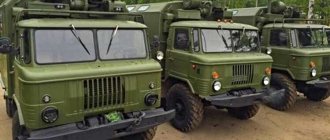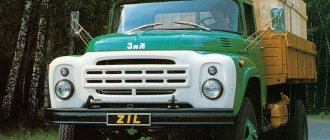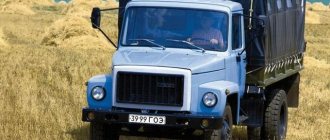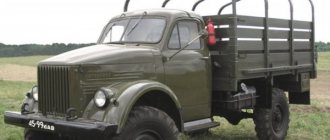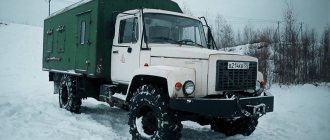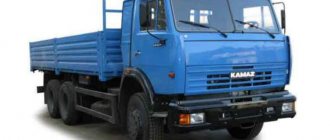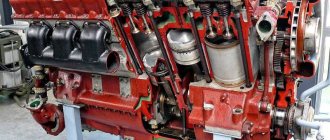ZIL 130 is a legendary truck of the Soviet era. In the line of the Likhachev plant, the model is the most widespread and successful product. The production of the car was organized at various enterprises, and the total production volume exceeded 3 million copies. The ZIL 130 has been on the assembly line of the Likhachev plant since 1964 and for a long time remained the standard in the medium-tonnage truck segment. For that period, this was a progressive model with high rates of profitability and durability.
The car was used in various fields, and the number of versions created on its basis reached several dozen. By the end of the 1980s, the ZIL 130 was seriously outdated. The design of the model, which had changed slightly since the start of production, no longer provided a competitive advantage. As a result, the car gave way to more progressive analogues. Currently, the ZIL 130 is difficult to find on the roads of the country. However, individual enterprises and farms continue to use this model.
Model history
A prototype of the truck was produced in 1956 at the Moscow Likhachev Automobile Plant. The developers' task was to replace the then obsolete ZIL-164 (by another marking - ZIS-150). Over the next 8 years, improvement and refinement continued. Only in 1963 the truck went into production and began to be produced en masse.
Important
After 10 years, the car was awarded the State Quality Mark. Already in mid-1974, the total number of produced ZILs of this model reached a million.
In the summer of 1982, the two millionth truck rolled off the assembly line. From the beginning of 1986, the designation of the vehicle was replaced by ZIL-431410. At the end of 1994, the plant stopped mass production of cars. Small batches of trucks of this model were also produced at different times by other factories in the country - the Chita automobile assembly plant, the Kutaisi automobile plant,
Chkalovsky Bus and Ural Automotive. Currently, you can still buy a used ZIL-130. Although it is quite difficult to come across such a proposal. Still, the car has not been produced for more than a quarter of a century.
PRICE OF NEW AND USED
Production of the ZIL 130 ended back in 1986, then the model began to be produced with a new name - ZIL 431410. At the same time, structurally and externally the truck differed little from its predecessor. Production of the legendary car ceased completely in 2010.
Currently, the ZIL 130 is practically not used, and there are very few used options on the market. The majority of them have high mileage and are in poor condition.
Average cost of a used ZIL 130:
- 1988-1990 – 70-150 thousand rubles;
- 1993-1995 – 100-270 thousand rubles.
Vehicle specifications
The popularity of the ZIL-130 truck is explained by several reasons. The main one is the optimal combination of technical and operational characteristics.
A significant role in this was played by the use of the best models of various foreign brands, including Dodge, Ford, GMC, Chevrolet and others, American and European, as basic ideas when designing a car.
Engine
The truck was equipped with various power plants over the years. The base ZIL-130 engine is a V-shaped overhead valve engine with a power of 150 hp. With. Its working volume was 5,969 cubic meters. cm. The engine was designed to run on the most popular gasoline in the USSR in those years, A-76. The power plant was equipped with a two-chamber K-88AE carburetor.
The engine power allowed it to reach speeds of up to 90 km/h. In addition to the basic one, a few years later the ZIL-130 diesel version began to be used. But this option was never widespread and was rather used individually.
Transmission
The truck was equipped with a 5-speed manual transmission. Its design involved the use of a dry single-plate clutch with a spring vibration damper. The main gear was double, having a pair of bevel wheels. Gear ratio – 6.32.
Brake system
The truck was equipped with drum brakes, which were installed on each wheel. Their operation was carried out using a pneumatic system. The parking brake had a similar device and blocked the driveshaft.
Electrical system
Designed for 12 V. Energy is generated by a 6ST-90-EM battery. 32.3701 was usually used as a generator, less often G108-V. The trucks were equipped with a ST130-A3 type starter, A11 and B114-B spark plugs and ignition coil, respectively.
Device
ZIL 130 has a fairly simple design. The front suspension is built on 2 semi-elliptic springs with shock absorbers and rear sliding ends, the rear suspension is built on 2 main and 2 additional semi-elliptic springs. These elements also received sliding ends.
The car has a rear-wheel drive axle and a dry clutch with a single disc. The ZIL 130 transmission is mechanical with one disc and a pair of synchronizers (for 2nd and 3rd, 4th and 5th gears). The 5-speed gearbox has a constant gear engagement with the exception of reverse and 1st gears. For the automotive industry of that time, this unit was considered new, but during its operation it changed several times. Torque is transmitted from the gearbox to the rear axle via a cardan shaft. For the ZIL 130 model, two shafts mounted on the frame were used. For versions with a shortened base, one shaft was used without an intermediate support. The first transmissions for the car were designed in 1961; 6 years later they underwent minor changes. In the restyled gearbox, the retaining ring was removed. The gear shift knob was insulated with a special rubber seal, which prevented moisture from entering the gearbox. The crankcase was made of high quality cast iron.
The braking system of the model consisted of drum-type brakes operating under the influence of a pneumatic system. A specialized tank with high pressure made it possible to maintain an air reserve. The parking brake used a drum that locked the driveshaft.
Electrical diagram of ZIL 130
The appearance of the ZIL 130 was very unusual for models produced in the 1960s, so the car immediately attracted the attention of others. The car received a non-military paint job for the first time. Previously, all the plant's products were khaki. Now there are modifications of white and blue colors. Streamlined fenders, an alligator-type hood and a panoramic windshield were prepared especially for the ZIL 130. Not all drivers were happy with this decision. Giving up the windshield did not happen right away. Another memorable element was the new shaped radiator grille.
The all-metal cabin was awarded an advanced design for that time. Moreover, even now it does not look outdated. In terms of comfort, the developers did a good job, and the ZIL 130 was head and shoulders above most competitors in this indicator. The 3-seater cabin (driver's seat and double seat for passengers), the width of which has been significantly increased, now has comfortable seats and a lot of space. The driver's seat was adjustable in vertical and horizontal directions. The angle of the backrest could also be changed.
The arrangement of instruments in the cockpit was almost ideal. The ZIL 130 was the first to use power steering, which made it unique for that time and increased safety. If a tire breaks on the road, it has become much easier to hold the car.
The truck received a classic wooden platform with a tailgate. It was considered a cargo-passenger vehicle and was also used to transport people. Conventional folding benches with a total capacity of 16 people were attached to the body side grilles. There was also a removable bench for 8 passengers. The basic configuration of the car included an awning and removable arches. The height of the body coincided with the height of the floor in the train cars, which made loading and unloading operations much easier.
Over its almost 50-year history, the ZIL 130 has established itself as a reliable, unpretentious and durable truck. At the same time, the car can still be found on Russian roads, which confirms its high quality.
Cabin
It was one of the most recognizable elements of the truck. For the 60s of the last century it had good ergonomics. The steering wheel was made in the form of a screw, equipped with a ball-shaped nut and a piston-rack with a built-in hydraulic booster.
Important
The cabin is designed for three people. The seats could be adjusted in three parameters - height, length and backrest angle.
There are two ventilation hatches mounted on the roof. Solid metal was used to make the cabin frame, which ensured strength, reliability and durability. Particular attention should be paid to the convenient location of controls and controls.
Peculiarities
ZIL-45065 is very popular in rural areas, where it often transports grain cargo. This is due to the fact that the standard cargo platform initially has a useful volume of 6 cubic meters, but if you install extension sides, it increases to 12.5 cubic meters. In construction, this indicator means little, since everything depends primarily on the carrying capacity of the truck itself, which is 5300 kilograms. In addition, the vehicle can unload in three directions, which is present in all grain trucks.
It would seem that there are now a lot of modern foreign analogues that are significantly superior to the domestic truck in many respects. However, the increased demand for this model is also explained by such qualities as low cost, reliability, endurance, and the availability of spare parts. In addition, thanks to the simple design, the driver can independently carry out any repair work, even quite serious ones. All these become key factors when choosing equipment for agricultural needs.
But the use of this model is not limited to agriculture alone. Equipment can often be found when working in various fields, including the construction of any objects and the removal of various materials.
The ZIL-508.10 eight-cylinder gasoline engine with a V-shaped cylinder arrangement was chosen as the power unit for the ZIL-45065. This engine has proven itself in many other trucks. It has high reliability, maintainability, and is also unpretentious to the quality of the fuel poured and operating conditions. However, in order to increase efficiency, many owners often install gas equipment. In addition, you can often find a truck with a D-245 diesel engine. This option, with four cylinders and a turbocharger, is capable of developing a maximum output power of 100 horsepower. Install it yourself.
Modifications
A large number of modifications released over the years played a huge role in the popularization of the truck. It makes sense to list the most popular of them:
- ZIL-130-66. Introduced into mass production in 1966. It differs from the basic version by installing a 150 hp engine. With. and several improvements. In fact, it is the most popular and widespread modification of the model, and therefore is often designated without adding the last two digits;
- ZIL-130-76. The key difference from the original version is the increased load capacity to 6 tons;
- ZIL-130-80. Equipped with three brake systems, independent of each other;
- ZIL-130A. A tractor with a flatbed that can be used with a trailer;
- ZIL-130B. An improved chassis, which includes a brake valve, electrical and pneumatic outlets, and several other improvements and changes;
- ZIL-130V. Truck tractor. Produced in two versions. The second - 130W - had a reinforced rear axle;
- ZIL-130G and 130GU. Long- and extra-long-wheelbase truck (4.5 and 5.6 m, respectively) with flatbed and universal chassis;
- ZIL-130D1 and 130D2. Chassis designed for industrial dump trucks of various modifications;
- ZIL-136I. Equipped with Perkins 6.345 diesel engine. Its power was 140 hp. With.;
- ZIL-130K. Chassis designed for industrial dump trucks with a 110 hp engine. With.;
- ZIL-138, 138A and 138I. Several modifications with a liquefied gas engine.
Truck modifications that differ in body type and additional equipment deserve special mention. These include:
- flatbed truck as standard;
- dump truck ZIL-130, which can be called the second most widely produced;
- van
- several types of truck cranes (the most common is KS 2571A);
- fire truck, designated ATs30(130)63;
- tanker or fuel truck.
Brake system
A dual-circuit braking system with pneumatic drives is responsible for braking the dump truck. All wheels are equipped with drum-type brakes.
Service brakes operate from the main circuit of the system. In case of any malfunctions, the car is braked using an additional line, which brakes the rear wheels using mechanical energy accumulators. It is worth noting that the main purpose of the additional brake line is primarily to activate the parking brake, where energy accumulators are also involved.
For greater reliability, a special alcohol fuse was added to the brake system. Thanks to this equipment, the condensate formed does not freeze, which in turn preserves the functionality of the brakes.
Reviews ZIL-131
According to reviews from drivers who have experience working with the ZIL-131, it is an extremely reliable, durable and “tenacious” car. And, of course, it has phenomenal cross-country ability. Which is capable of successfully making its way even with a fully loaded body along wet and broken field roads; and along clay slopes; and along sand dunes; and along the rough terrain blurred by heavy rains - “where tanks would get stuck.”
The presence of a downshift is very pleasing and helps out. Mechanical tire inflation works effectively, making it possible to adjust tire pressure for driving on various road and off-road surfaces (snow, wetlands, soil), “though you must remember to open the valves on the wheels.”
The driver’s car is simple, “almost the same 130.” The only difference is the cabin and the presence of a middle axle, as well as, of course, all-wheel drive. Excellent access for repairs and maintenance is available from all sides. Removing the engine is very simple.
The gasoline consumption of the ZIL-131, by today's standards, is simply mind-blowing and terrifying. However, in Soviet times this issue was not at all as pressing as it is now. Gasoline in the 70s cost 6 kopecks per liter. And who bought it for ZIL-131? There were no privately owned trucks back then. All of them belonged to the state and, accordingly, were refueled at its expense.
The cabin, of course, is very “Spartan”: you can immediately see that it is a working one, or a “soldier’s one”, and the list of amenities in it is minimal: “it’s good that the doors close, the glass is intact and the stove heats up!” “That’s all the convenience.” But the heater is excellent, “it works like a blast furnace”: in five/ten minutes you’re sitting as if in the tropics.
For long trips on the highway, the ZIL-131 is of little use: sitting in its cabin is hard, shaking, at speeds over 65 km/h - it’s already so noisy that you can hardly understand the words of your interlocutor.
The conclusion is simple: if on a normal asphalt road anyone would choose another truck, then where the road ends and rough terrain begins, few trucks can compete with the ZIL-131.
Prices for "ZIL-131"
There are many advertisements on the Internet for the sale of used ZIL-131 trucks of various options - flatbeds, dump trucks, fuel tankers; with a kung van.
The price range is wide: from 100 to 300 thousand rubles (depending on the technical condition) are asked for cars produced in the 70s-90s.
For those removed from conservation, with low mileage, they are much more expensive - from 500 to 700 and even 950 thousand (more economical diesel ones are more expensive). But some of these examples also look like “a hunter’s and traveler’s dream”: their kung van is well equipped and modified.
